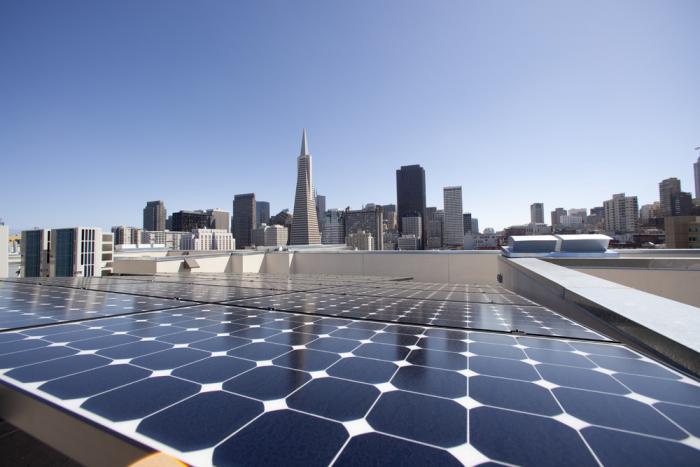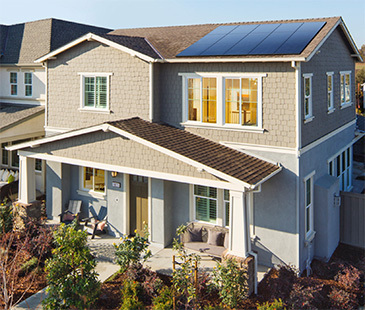
Editor’s Note: In February 2022, SunPower’s Commercial and Industrial Solutions business was acquired by TotalEnergies. Find out more about sustainability options for these industries.
In very simple terms, figuring out “How many solar panels do I need?” is a matter of dividing how much energy a solar panel can provide by how much your business uses. But you didn’t come here for “simple,” did you? You want a real answer.
Let’s dig a little deeper and put some actual numbers into our formula. Consider the following example:
A medium-size business uses about 25,000 kilowatt hours (kWh) of electricity each year. That works out to approximately 70 kWh used each day.
Next you need to know how much electricity solar panels can generate. An average solar panel can produce approximately 250 watts of peak power (this is also called its “nameplate rating”). The actual number depends primarily on the efficiency of the solar panel design.
Finally, you need to know how much peak sunlight you receive each day. In the U.S., that ranges from about 4 to 6 hours of sunlight per day. For this simplified example, let’s call it an average of 5 hours of daily direct sunlight.
Now let’s do the math (Figure 1):

This basic formula shows a requirement of 14 kW. But we’re still not quite done. At the risk of complicating things a bit more, solar panels generate DC (direct current) electricity. Businesses use AC (alternating current). The conversion from DC to AC power isn’t perfectly efficient—typically somewhere around 80%. So you actually need to generate more than 14 kW (Figure 2). You’ll wind up needing approximately 17.5 kW to cover 100% of the energy needs.

To calculate the average number of solar panels you’ll need, divide the total required kilowatts by the solar panel’s nameplate rating (Figure 3). This example uses average-quality 250-watt panels:

Okay, let’s recap: A medium-sized business using an average amount of electricity needs approximately 70 average-quality solar panels to meet 100% of its electricity needs. These are just averages, but you get the idea. As it turns out, calculating how many solar panels your organization needs is not exactly rocket science.
Uncovering the underlying complexity
While it’s easy to find online calculators to plug in information such as the example above, the resulting answer to “How many solar panels to power a business?” is a “back-of-a-napkin” calculation at best. Read the fine print and you’ll find plenty of disclaimers about how your particular situation may vary, along with a contact form to fill out for more information (i.e., a sales call).
The truth is, calculating how many commercial solar panels you need likely goes beyond the capabilities of an online app. Consider the scenario outlined above. While it might be possible to determine how many solar panels are needed to cover average daily needs—what if your needs aren’t average? A printing company producing quarterly reports, for example, will experience spikes in energy usage four times each year. Can a commercial solar power system set up for average daily use meet the real-world electricity demands on days during these peak periods? Does an online calculator understand that the space you have available for solar panels is in the shadows of nearby trees for a portion of the day? Does an app factor in your organization’s financial and environmental goals for going solar? Probably not.
If you’re starting to seriously consider solar (a good assumption since you’re wondering how many panels you’ll need), it may be a good time to engage the services of an independent solar energy consultant or contact a knowledgeable solar provider. They can help educate you about some of the more nuanced factors hidden in the relatively simple calculation shown above. But whether you decide to hire an energy consultant, talk to a solar company or choose to sort through the options yourself, let’s cover the things you should definitely be thinking about.
When average isn’t so average
As mentioned above, understanding the specific energy needs for your operation is key. Energy fluctuations aren’t limited to month-to-month changes. Chances are, your local utility can help with reports tracking your yearly, monthly and even daily usage. You might discover your business is experiencing predictable spikes in electricity use at regular intervals on a daily basis. Rather than installing additional panels to meet peak consumption needs, perhaps a better solution would be to attach a commercial solar battery storage system to help level out demand and lower your commercial electricity demand charges. A little investigating will help you better understand your specific needs and the various solutions available to meet them.
Understanding your solar energy goals
It sounds obvious, but if your objective is to reduce or stabilize your utility bill by a certain amount, you need to identify that specific goal. The number of commercial solar power panels you need will be dramatically different if you’re looking to reduce costs by 50%, as opposed to covering 100% of your energy needs. And if net metering is an option in your area, you might want to install even more panels to take advantage of the credit you could receive by sending unused solar energy back into the grid. Partnering with a solar energy consultant or solar equipment provider who understands your unique objectives is key to calculating your solar panel needs.
Quality vs. quantity
For example, if solar panel A is rated at 200 watts and solar panel B is rated at 350 watts, it stands to reason that you will need fewer B panels to produce the same amount of solar electricity. When it comes to evaluating solar panel design, ratings matter—but they only tell part of the story.
A solar panel efficiency rating is also important. It refers to the portion of sunlight energy that is converted into electricity. For example, a panel with a 20% efficiency rate would produce an amount of power equal to 20% of what it receives from the sun. (And 20% is actually very good. Commercially available solar panels currently average a 15% to 24% efficiency rate.) If a solar panel’s photovoltaic (PV) cells are more efficient, you need fewer panels to meet your electricity production goals.
A solar panel’s degradation rate can also impact how many solar panels you need. All solar cells degrade over time. Suffice it to say, the lower the degradation rate, the faster you can realize the commercial solar savings. Perhaps more importantly, predicting the amount of solar power that’s expected to be generated over 20 or 30 years (or more) can help determine how many solar panels are needed.
Finally, while not necessarily a factor in how many solar panels you’ll need, durability is definitely a factor in how many solar panels you’ll need to purchase over the lifetime of your installation. If you plan to use your system in a harsh environment (e.g., desert heat, mountain snow or coastal sea air), the durability of your solar equipment could be a significant factor. Less expensive panels are no bargain if you need to replace them more frequently. And while we’re on this topic, keep in mind that panel warranties matter as well.
Making a statement with solar panels
There are also less tangible factors that can go into determining how many solar panels are needed to power a business. For example, while a rooftop installation might be a viable option, your organization might opt to make a more public display of its commitment to corporate sustainability initiatives. A carport installation could visually demonstrate that commitment while also providing shaded parking for employees and customers. Perhaps providing solar-powered electric vehicle (EV) charging stations as part of the installation could help attract socially-conscious employees and clients. Looking beyond the obvious bottom-line benefits of commercial solar energy can help you see other potential social and ecological “wins”—which can translate to bottom-line benefits as well.
Solar panel rocket science?
By now you’ve probably come to the conclusion that answering “How many solar panels do I need?” is not, in fact, rocket science. Hopefully, you’ve also discovered that it involves a much more complex and nuanced calculation than you might otherwise have considered. While it’s important to get to that final figure, it’s even more important to answer the underlying questions hidden within the formula. Only then will you accurately know how many solar panels you need to power a business.

